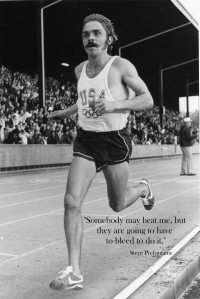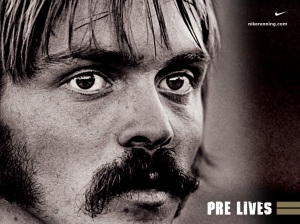Every morning this is the first thing I see.
It’s not by design that I wake up to this portrait of Steve Prefontaine. It’s purely by accident.
A few months ago I took my current job working as a supply teacher in Aberdeen. I needed a place to stay short-term so I rented a room from an old university friend. This old friend, unbeknownst to me before I moved in, has a curious obsession with Steve Prefontaine. He has a t-shirt, he has a DVD and, hanging on the wall in my room, he has that portrait (no doubt he has placemats and mugs and bumper stickers somewhere too).
But, and this is the thing that you need to understand, my friend isn’t a freak. He’s not alone in this. There are a lot of people who have Prefontaine on their walls; it’s just that most of them live in America. Go into any house in America (preferably with permission) and there is a reasonable chance that Prefontaine’s moustachioed face is going to be there, on a t-shirt or in a book, or hanging framed next to a bookcase or above a mantelpiece or in the toilet. He could be anywhere.
Why though? It’s reasonable to expect that you haven’t heard of Steve Prefontaine before. Maybe from the portrait and the subject of this blog you can guess that he’s a runner. You’d probably guess that he was a successful one too, a world record holder or an Olympic medallist at the very least.
You might be surprised to hear that while Prefontaine was a runner he never did break a world record or win an Olympic medal. That’s not the allure with Prefontaine, there were other things that made him special.
Prefontaine was rebel, a man who defied convention. For a start he didn’t look anything like a distance runner: with his tousled golden locks, moustache and intense eyes – eyes that look like they’ve seen stuff, you know, heavy stuff – he looked more like a Vietnam veteran than an athlete. There was the way that he ran too, always hard from the gun. Prefontaine preferred to pummel his opponents into submission by setting a fast, unrelenting pace rather than rely on a quick finish in the end.
Prefontaine, to use the American vernacular, had balls. Before the Olympic 5000 metre final at the 1972 Munich games (a race he would finish 4th in) he said: “Somebody may beat me, but they are going to have to bleed to do it.” As far as Prefontaine was concerned running wasn’t about who could move their legs more quickly, it was about who had a bigger heart and, ultimately, who could suffer more pain.
There are other reasons why the Americans have such a love affair with the legend of Steve Prefontaine. Like all good heroes he came from lowly immigrant stock but managed to strike gold in the land of opportunity. Prefontaine is, in a way, running’s Rocky facsimile: an emblem of the American dream and proof that no matter how poor or how foreign you are, anything is possible.
And like other heroes Prefontaine had a real distaste for authority. He was a man who didn’t think twice about sticking it to ‘the man’. For many years he fought doggedly against the Amateur Athletic Union, a body that decreed American athletes must not be paid to perform if they were to compete in the Olympics. Frustrated by the hypocrisy of race organisers profiting from athletes who were, at the time, paid nothing, Prefontaine set about changing the system. Like a modern-day Spartacus, Prefontaine crusaded for American athletes to be freed from the oppressive body that enslaved them so that they might profit from their exploits.
But there’s one more reason why the mystique surrounding Prefontaine hangs so thick: he died young. One of the darker facets of human nature is that we like our heroes dead – it’s safer to eulogise them that way. I suppose people prefer to think about what men could have done than what they didn’t do. Those who die before their time will forever be connected to those two big towering words: what if. When he died in a car accident aged 24, we would never the chance to find out if Steve Prefontaine could avenge his defeat in Munich at the Montreal Olympics in 1976. We would never know if he was capable of breaking a world record. And we would never see how far and fast he could really go.
It sounds mawkish to say that someone has inspired you under almost any circumstances (an Oscar acceptance speech being a notable exception). But at the risk of sound like a Mariah Carey lyric I have to say that Steve’s spirit inspires me when I run. And that’s not because I want to emulate the man in the portrait gliding down the beach in the vest, his mouth mantelpieced by a moustache. It’s the sentiment that I buy into – running isn’t about floating or gliding anywhere, it’s about feeling like your chest has been napalmed and still carrying on, it’s about having a stitch and not stopping, it’s about getting to the crest of the hill. It’s about heart and character and it’s about guts.
As Steve says: “To give anything less than your best is to sacrifice the gift.”




Nice blog, man. Enjoying it.
Thanks man, I’m glad you enjoy it/read it in the first place.